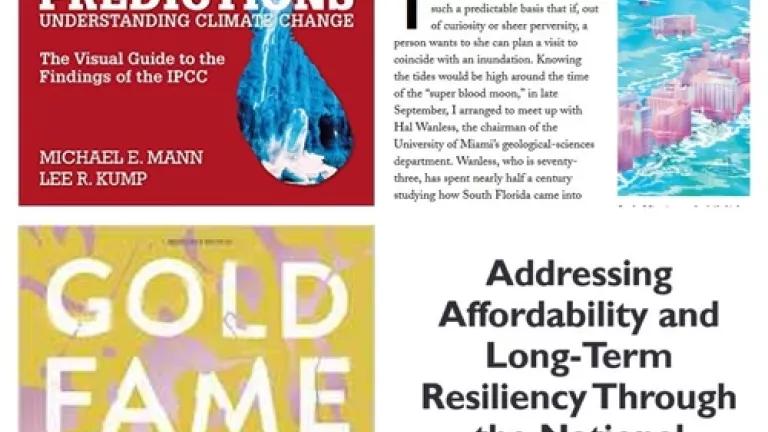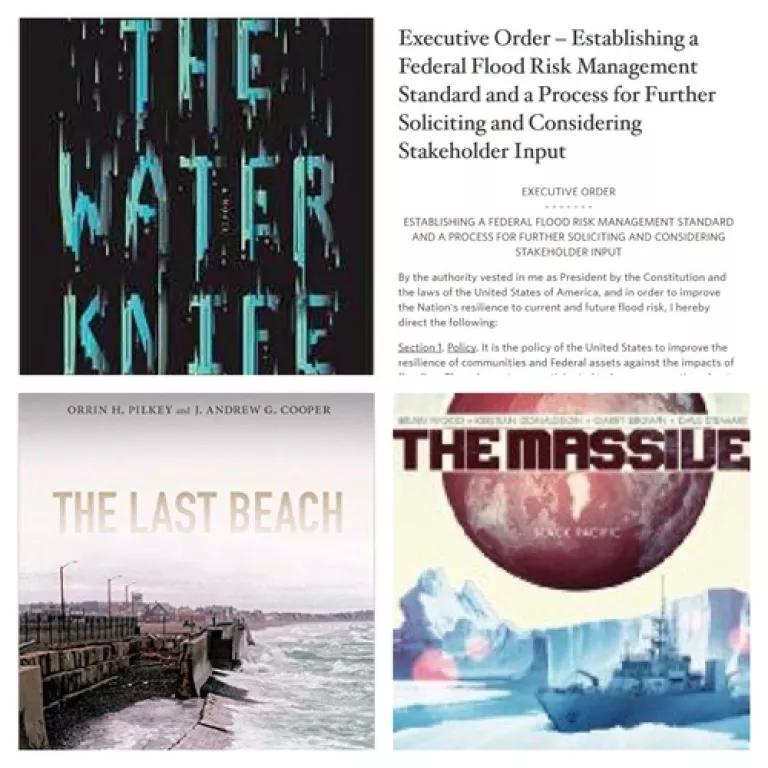
I decided to try my hand at a "Best of 2015" reading list. I read a wide variety of materials for work and pleasure on the topic of climate change impacts ranging from academic literature to policy proposals to graphic novels. There was no way to rank such a diverse array of material, so I'm just going to put it out there, broken down by category.
Below, in no particular order or ranking, are the readings that grabbed my attention about climate change and its impacts. I'll also warn you that it skews heavily towards sea level rise and flooding, because that's what I happen to work on the most.

Deep Dives
Dire Predictions-Understanding Climate Change -- Michael Mann and Lee Kump
This second edition of this awesome fact- image-infographic-filled book will have you terrified about the future of the planet in short order, but in an, "Oh my, that is very interesting," kind of way. If there is one book to get about climate change -- its causes, its impacts, and what we can and should do about it -- this is the one.
Take away: If you want to come out on top in a debate/throw-down about climate change, this is your crash course and key to victory.
The Last Beach -- Orrin Pilkey, Jr.
This book documents the perils of putting permanent structures (i.e. houses) on barrier islands and coastlines that have an annoying habit of moving (despite the Army Corps of Engineers efforts to pin them in place). This book also takes a hard look at how problems of coastal development magnify in the face of climate change and sea level rise.
Take away: When it comes to beachfront property, rent, don't buy.
Academic Articles
Ice melt, sea level rise and superstorms: evidence from paleoclimate data, climate modeling, and modern observations that 2C global warming is highly dangerous -- James Hansen, et al.
This paper made serious waves, both because the lead author was James Hansen, the former NASA researcher who's been warning us about climate change longer than anybody, and because this paper drew some conclusions that make you say, "HOLY MOLY, that's bad news!" The authors point out that the last time the planet was one degree Celsius warmer than today, sea levels were 5m - 9m higher (16.4-29.5 feet)! We're so accustomed to seeing sea level rise projections that only go to the end of this century that we forget seas will rise far into the future.
Take away: It's not a question of how high sea levels will go, it's how fast sea levels will go that high.
Carbon choices determine US cities committed to futures below sea level -- Ben Strauss, et al.
Want to know how high sea levels might go under different emissions scenarios? Want to find out what that might mean for specific cities in the U.S.? You'll find some very good information here, including projections of when emissions will hit a level that makes inundation of each city very likely. New Orleans? It's already too late. Charleston, SC? Best case scenario is 2050, unless the West Antarctic Ice Shelf collapses, then it's already too late.
Take away: It's not how high sea levels will go, it's how much higher they'll go if we don't start cutting emissions (like NOW...no really, right now).
The changing nature of flooding across the central United States (Iman Mallakpour and Gabriele Villarini, University of Iowa) and Statistics of Evolving Populations and Their Relevance to Flood Risk (Robert Criss, University of Washington in St. Louis).
Everybody talks about sea level rise, but rivers across the Midwest are out of whack, too, as evidenced by record-breaking end of year floods on the Mississippi River. These two papers will reassure you that it's not your imagination; rivers are flooding a lot more frequently than they used to.
Take away: How many one-hundred year floods can you expect in one hundred years? The answer is, apparently, "a lot more than one hundred years ago."
Policy Proposals for Dealing with Sea Level Rise and Increased Flood Risk
Addressing Affordability and Long-Term Resiliency Through the National Flood Insurance Program Becky Hayat and Rob Moore
Yep, I'm shameless. I'm giving a paper I co-wrote top billing in this section over President Obama (I'm pretty sure he'd do the same to me). But in all seriousness, we need to do things differently if we are going to prepare for and adapt to the reality of sea level rise and the growing risk of flooding. Our paper describes a couple of options whereby the troubled National Flood Insurance Program could help people move out of harm's way instead of into harm's way, which federal flood insurance has been helping make happen since the 1970s.
Take away: People are going to need help getting out of harm's way; let's give it to them before they run out of options, not after.
Executive Order 13690 Establishing a Federal Flood Risk Management Standard President Barack Obama
With little fanfare or attention, the President took a big step on climate change this year (no, not the one that will drive power plant emissions down). This executive order requires all federal agencies to factor in an additional margin of safety and consider how climate change affects sea level rise and future risks of flooding before committing federal money to the construction of public infrastructure and facilities, including projects done by state and local governments using federal money. While it hasn't gotten a lot of attention, except from members of Congress who wanted to block it, this should shift hundreds of billions of dollars in federal funding away from vulnerable coastlines and floodplains.
Take away: If you don't build it, they won't come (to the floodplain).
Fiction
The Water Knife by Paolo Bacigalupi
In the future, water will be pretty scarce in the Western U.S. Today, we settle our disputes over water rights in the courts. In the future portrayed in this book, once the courts rule, cities back their lawyers with armed strike teams. And when water rights are up for grabs, you send in some pretty nasty characters to track them down and get them, no matter who gets in their way.
Take away: I loved this book. Enough said.
Gold Fame Citrus by Claire Vaye Watkins
In Los Angeles, the water's gone and most of the people are gone too. And somewhere beyond the city, a massive sea of sand dunes now dominates the horizon thanks to decades of drought. With this as the backdrop, our characters stumble into the dunes searching for a new start, and may have found it.
Take away: There's a reason why this book is making it on so many "best of 2015" literature lists. It's beautifully written and paints a fascinating picture set in what could be our pre-apocalyptic future.
The Massive by Brian Wood and Kristian Donaldson (5 volumes)
This five-volume graphic novel series follows the crew of the Kapital, a ship that's roaming a future world where sea levels have inundated most of the coastlines and sent nations and newly formed city-states spasming into survival mode. The ship belongs to a direct action environmental group, captained by a former mercenary, who suddenly have to confront what it means to be environmentalists at the end of the world.
Take away: As these volumes rolled out starting in 2013 and ended in 2015, I couldn't wait to get a hold of each and every one. You shouldn't wait, either.
Sadly, Not Fiction
The Siege of Miami by Elizabeth Kolbert, The New Yorker
Last, but by no means least, is this piece from the December 2015 edition of the New Yorker. Renowned writer Elizabeth Kolbert has explored the impacts of climate change before, but in this article she goes to see how it's playing out in Miami, where floods are now an all-too-regular fact of life. As Kolbert vividly describes through interviews with area residents and experts, Miami now floods in response to high tide. No storms are needed to send water into the streets and into people's houses.
Take away: You've heard of the proverbial canary in a coalmine...this is that for sea level rise.

